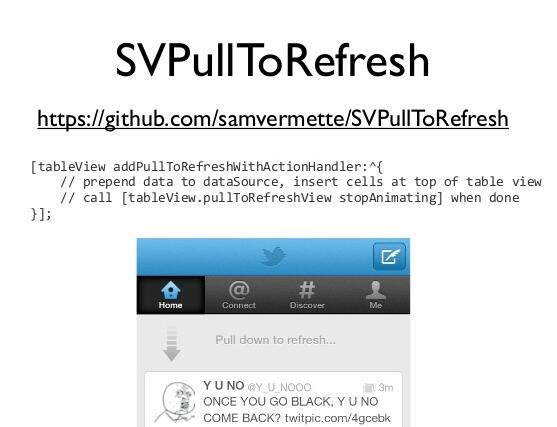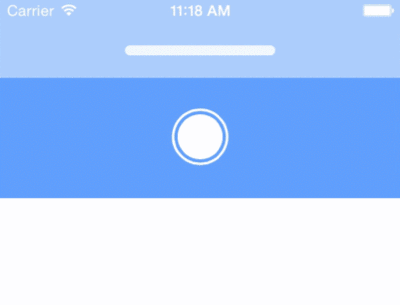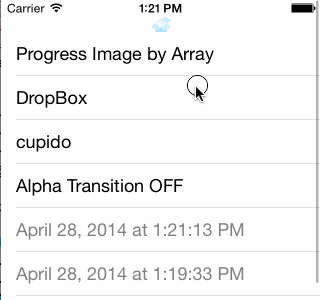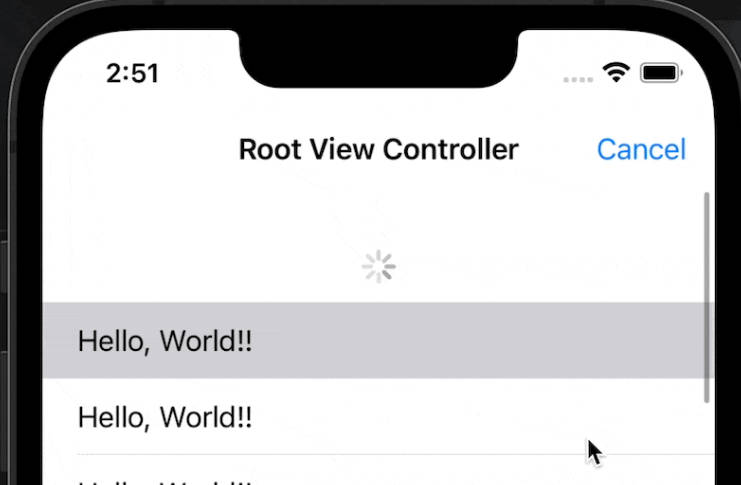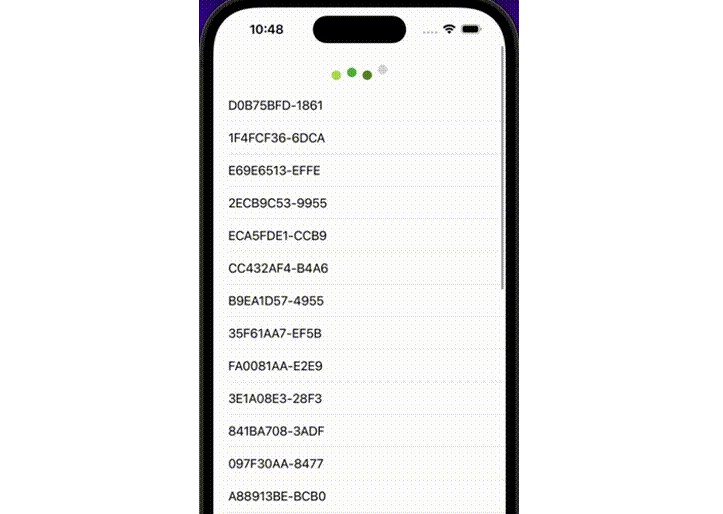SVPullToRefresh + SVInfiniteScrolling
These UIScrollView categories makes it super easy to add pull-to-refresh and infinite scrolling fonctionalities to any UIScrollView (or any of its subclass). Instead of relying on delegates and/or subclassing UIViewController, SVPullToRefresh uses the Objective-C runtime to add the following 3 methods to UIScrollView:
- (void)addPullToRefreshWithActionHandler:(void (^)(void))actionHandler;
- (void)addPullToRefreshWithActionHandler:(void (^)(void))actionHandler position:(SVPullToRefreshPosition)position;
- (void)addInfiniteScrollingWithActionHandler:(void (^)(void))actionHandler;
Installation
From CocoaPods
Add pod 'SVPullToRefresh' to your Podfile or pod 'SVPullToRefresh', :head if you're feeling adventurous.
Manually
Important note if your project doesn't use ARC: you must add the -fobjc-arc compiler flag to UIScrollView+SVPullToRefresh.m and UIScrollView+SVInfiniteScrolling.m in Target Settings > Build Phases > Compile Sources.
- Drag the
SVPullToRefresh/SVPullToRefreshfolder into your project. - Add the QuartzCore framework to your project.
- Import
UIScrollView+SVPullToRefresh.hand/orUIScrollView+SVInfiniteScrolling.h
Usage
(see sample Xcode project in /Demo)
Adding Pull to Refresh
[tableView addPullToRefreshWithActionHandler:^{
// prepend data to dataSource, insert cells at top of table view
// call [tableView.pullToRefreshView stopAnimating] when done
}];
or if you want pull to refresh from the bottom
[tableView addPullToRefreshWithActionHandler:^{
// prepend data to dataSource, insert cells at top of table view
// call [tableView.pullToRefreshView stopAnimating] when done
} position:SVPullToRefreshPositionBottom];
If you’d like to programmatically trigger the refresh (for instance in viewDidAppear:), you can do so with:
[tableView triggerPullToRefresh];
You can temporarily hide the pull to refresh view by setting the showsPullToRefresh property:
tableView.showsPullToRefresh = NO;
Customization
The pull to refresh view can be customized using the following properties/methods:
@property (nonatomic, strong) UIColor *arrowColor;
@property (nonatomic, strong) UIColor *textColor;
@property (nonatomic, readwrite) UIActivityIndicatorViewStyle activityIndicatorViewStyle;
- (void)setTitle:(NSString *)title forState:(SVPullToRefreshState)state;
- (void)setSubtitle:(NSString *)subtitle forState:(SVPullToRefreshState)state;
- (void)setCustomView:(UIView *)view forState:(SVPullToRefreshState)state;
You can access these properties through your scroll view's pullToRefreshView property.
For instance, you would set the arrowColor property using:
tableView.pullToRefreshView.arrowColor = [UIColor whiteColor];
Adding Infinite Scrolling
[tableView addInfiniteScrollingWithActionHandler:^{
// append data to data source, insert new cells at the end of table view
// call [tableView.infiniteScrollingView stopAnimating] when done
}];
If you’d like to programmatically trigger the loading (for instance in viewDidAppear:), you can do so with:
[tableView triggerInfiniteScrolling];
You can temporarily hide the infinite scrolling view by setting the showsInfiniteScrolling property:
tableView.showsInfiniteScrolling = NO;
Customization
The infinite scrolling view can be customized using the following methods:
- (void)setActivityIndicatorViewStyle:(UIActivityIndicatorViewStyle)activityIndicatorViewStyle;
- (void)setCustomView:(UIView *)view forState:(SVInfiniteScrollingState)state;
You can access these properties through your scroll view's infiniteScrollingView property.
Under the hood
SVPullToRefresh extends UIScrollView by adding new public methods as well as a dynamic properties.
It uses key-value observing to track the scrollView's contentOffset.
